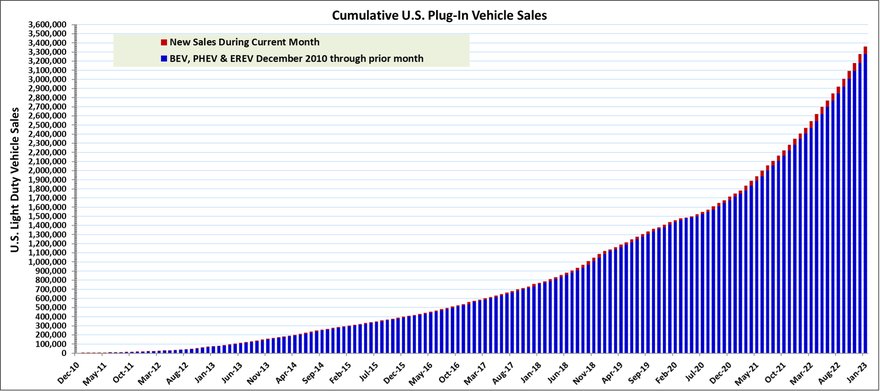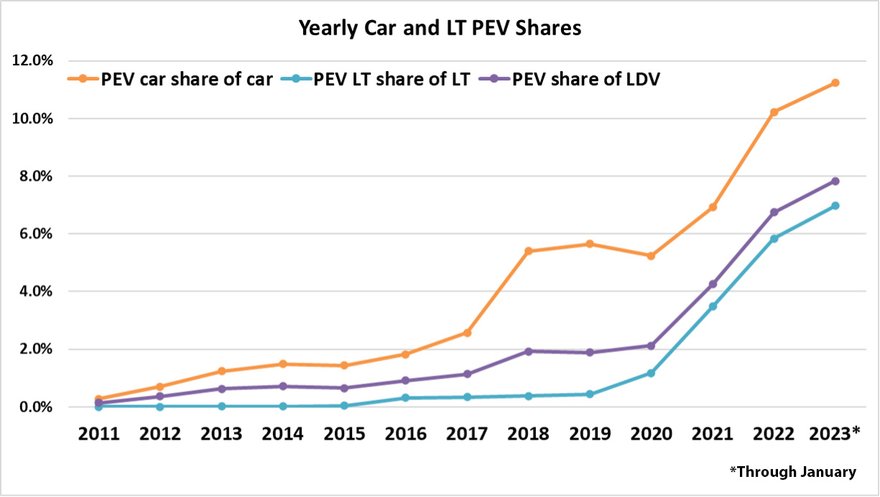Electric vehicles (EVs) are in the news seemingly every day. Between price drops, safety recalls, trade wars, bombastic executives, and a variety of other issues, EVs are constantly in the public eye.

But what does the data actually say about electric vehicles? How many are on the roads in the U.S.? Who's selling most of them? Are there more hybrids or plug-in hybrids out there? What do consumers think about hybrids and electric cars? (The Motley Fool surveyed 2,000 Americans to find the answer to this last question.)
Whether you're considering buying an electric car, thinking about investing in the EV space, or are just curious about the electrifying vehicle fleet of the United States, we have answers for you.
Key findings
- Almost 3.4 million plug-in electric vehicles have been sold since the first EVs debuted in the U.S. in 2010.
- Toyota (NYSE:TM) is the strongest seller of hybrids and plug-in hybrids, while Tesla (NASDAQ:TSLA) dominates the battery electric vehicle market.
- Over half of surveyed consumers are at least somewhat likely to buy a hybrid or electric car or truck for their next vehicle.
- About two-thirds of surveyed consumers oppose state legislation to phase out the sale of gas-powered vehicles.
A note on types of electric vehicles
In this article, we talk about a range of vehicles that rely partially or completely on battery power. Here's a quick guide to the different types and their abbreviations:
- Electric vehicles (EVs) don't use any gasoline. They're powered only by an internal battery, which is why they're also known as battery electric vehicles (BEVs). They're charged by plugging them into an outlet or charger.
- Plug-in hybrid electric vehicles (PHEVs) have both an internal combustion engine and an electric motor, but they're plugged into an outlet or charger to provide more power to the battery. Most can run in "EV mode" where the internal engine isn't engaged, but they can also run solely on the engine if the battery runs out of power.
- Plug-in electric vehicles (PEVs) is a category that includes both EVs and PHEVs.
- Hybrid electric vehicles (HEVs) use both gasoline and an electric motor. They can't be charged by external means and often use regenerative braking and the car's engine to charge the battery.
- Fuel cell electric vehicles (FCEVs) are powered by an internal hydrogen fuel cell. While they're quite rare in the U.S., the acronym does come up when you're reading about EVs, so it's worth knowing.
The current state of EVs in the United States
According to the Argonne National Laboratory (ANL), the first hybrid electric vehicle (HEV) sold in the United States was the first-generation Honda (NYSE:HMC) Insight in December 1999. The first plug-in hybrid electric vehicle (PHEV) and battery electric vehicle (BEV) were the General Motors' (NYSE:GM) Chevrolet Bolt and the Nissan (OTC:NSANY) Leaf, both of which started sales in December 2010.
Electric vehicles have been on the roads in the United States for almost 25 years. How far have they come?
ANL data doesn't provide cumulative hybrid sales, but shows that almost 3.4 million plug-in electric vehicles (PEVs) have been sold since the Bolt and Leaf debuted in 2010. Monthly sales have seen a notable increase since the middle of 2021, indicating strong interest from the market (consistent EV-related tax breaks undoubtedly help).

Plug-in vehicles are outpacing hybrids despite being more expensive
In January 2023, 59,137 HEVs (10,813 cars and 48,324 light trucks) were sold in the United States, compared to 80,859 plug-in vehicles (66,416 BEVs and 14,443 PHEVs). HEV sales were down 6% from January 2022, while HEV sales were up an astonishing 48%.
This is especially impressive considering the typical prices of PEVs. According to Kelley Blue Book, the average transaction price for a new non-luxury vehicle in December 2022 was $45,578, while the average for a new electric vehicle was $61,448.
That means the average new EV is almost $16,000 more than the average non-electric vehicle. And that includes trucks and SUVs (which make up about 75% of the car market in the U.S.), so the average increase over a comparable non-electric car is probably significantly more.
New hybrids, however, are much closer in price to their non-electrified equivalents. In September 2022, Kelley Blue Book reported the following averages:
- New compact car: $26,296
- New mid-size car: $32,266
- New hybrid car: $32,944
Plug-in vehicles now make up almost 12% of the car market
ANL's monthly reporting shows that PEVs have made up almost 12% of the car market so far in 2023. If trends continue, this number could be much higher within the next five years:

It's important to note that this doesn't include non-plug-in hybrids. Every car in that 12-ish percent needs to be plugged into a wall at some point.
Which brands sell the most electric vehicles in the United States?
Finding exact numbers for HEV and PEV sales in the United States is a challenge. But here's what we were able to dig up.
According to Statista, Toyota dominates the market for hybrid and plug-in hybrid vehicles (over 96,000 sales in Q3 2022). This is no surprise with the perennial popularity of the Prius, RAV4, and Camry hybrids. Ford (NYSE:F) (23,000 sales), Honda (20,000 sales), Hyundai (OTC:HYMTF) (17,000 sales), and Toyota's Lexus (15,000 sales) were next on the list, but none of them come close to matching Toyota's own-label dominance.
When it comes to BEVs, though, the story is different. According to a Cox Automotive report, Tesla sold an incredible 64.5% of the EVs bought in the United States in 2022 (that's a total of 522,388 vehicles). Ford came in a distant second with 7.6% (61,575 vehicles sold).
What do consumers think of electric vehicles?
If we're talking about the future of the electric vehicle industry, we need to talk about consumer outlook. Many car manufacturers are committing to significant or even full electrification of their product suite, but how do consumers feel about it?
In a January 2023 survey, The Motley Fool asked 2,000 American citizens whether they owned a hybrid or fully electric vehicle. Only 20% said yes:
| Do you currently own a hybrid or electric vehicle? | Percentage of respondents |
|---|---|
| No | 80% |
| Yes, a non-plug-in hybrid | 7% |
| Yes, a plug-in hybrid | 7% |
| Yes, a fully electric vehicle | 6% |
However, 57% of our respondents also said they're at least somewhat likely to buy a hybrid or electric car or truck for their next vehicle.
| How likely are you to buy a hybrid or electric car/truck for your next vehicle? | Percentage of respondents |
|---|---|
| Very likely | 23% |
| Somewhat likely | 34% |
| Somewhat unlikely | 18% |
| Very unlikely | 25% |
Consumer divisions on electric vehicles largely fall along political party lines
As with the results of our survey on renewable energy investing, our respondents were split along party lines when it came to electric vehicles.
For example, when asked about how likely they are to buy a hybrid or electric vehicle car or truck for their next vehicle, about 66% of Democrat-leaning respondents were at least somewhat likely, while about 50% of Republican-leaning respondents said the same.
Similarly, when we asked those who were very unlikely to buy an EV why that was the case, most people said that they're too expensive. This was also true of left-leaning respondents. But those who tend to vote Republican were most likely to say that they'd rather drive a gas vehicle (this is also true of male respondents, regardless of political affiliation).
Consumers oppose legislation phasing out the sale of gas-powered vehicles
Another party split is obvious when it comes to states passing legislation that requires the phasing out of gas-powered vehicles.
| Should state governments pass legislation to phase out the sale of gas-powered vehicles? | Percentage of respondents |
|---|---|
| No | 65.35% |
| Yes | 34.65% |
About two-thirds of our respondents said that states shouldn't pass these kinds of laws. But only 51% percent of Democrat-voting respondents said states shouldn't require the phasing out of gas-powered vehicles (76% of Republican-voting respondents said the same).
The future of hybrid and electric vehicle manufacturing
Consumers are warming up to EVs -- but what about manufacturers? What are their plans for their EV fleets?
In general, car makers are looking to amp up their electric vehicle production. A few have even committed to releasing only EVs within the next decade. Here are seven companies' goals, as reported by the International Energy Agency:
- BMW (OTC:BMWYY) (OTC:BAMXF): Half of vehicles sold to be fully electric by 2030 or earlier.
- Ford: One-third of sales to be fully electric by 2026 and half by 2030. All European sales electric by 2030.
- GM: Offer 30 EV models and have BEV production capacity of 1 million units in North America by 2025.
- Daimler's (OTC:MBGY.Y) Mercedes: All newly launched vehicles to be fully electric by 2025.
- Toyota: Sell 3.5 million electric cars annually by 2030. Offer 30 BEV models by 2030.
- Volkswagen (OTC:VWAGY): All-electric vehicles to exceed 70% of Chinese sales, 50% of American sales, and 50% of European sales by 2030.
- Volvo, owned by Geely Automobile Holdings Limited (OTC:GELYF): Become a fully electric car company by 2030.
Consumer Reports also provides a detailed breakdown of 17 different North American car manufacturers and their plans, goals, and projections when it comes to EVs.
While it remains to be seen whether these companies will hit their goals, it's clear that a large portion of the auto industry will be electrified by 2030. It's worth noting that none of these plans are binding -- GM has already announced a slight delay in its goals because of slower-than-expected production of batteries.
While increasing demand for EVs undoubtedly plays a role in these electrification goals, governmental priorities have also likely encouraged companies to electrify.
Governments continue to push for electric vehicles
Governments around the world, from individual states in the U.S. to multinational declaration signatories, have pledged to shift the balance of vehicles toward electric.
For example, California is investing $10 billion to eliminate all non-zero-emission vehicle sales by 2035. Almost all states have some form of policy promoting electric vehicles. These can include tax credits, rebates, and registration fee reductions.
And according to the National Conference of State Legislatures, at least 13 states (California, Colorado, Connecticut, Maine, Maryland, Massachusetts, New Jersey, New York, Oregon, Rhode Island, Virginia, Vermont, and Washington) as well as the District of Columbia have followed California in requiring manufacturers to sell a certain number of zero-emission vehicles annually.
Related EV and automotive topics
The Biden White House has set a national goal for 50% of all vehicles sold to be electric by 2030. A recent piece of legislation also earmarked $7.5 billion to build a national network of 500,000 charging stations (at the time of this writing the Alternative Fuels Data Center reports 51,000 locations and 133,000 ports).
Globally, other countries are following suit. Both Canada and the United Kingdom have made moves to ensure that all cars sold will be electric by 2035. China has required manufacturers to sell 40% EVs by 2030.
And at the United Nations' Climate Change Conference in 2021, 100 stakeholders, including governments, auto manufacturers, investors, and others signed a declaration to hasten the electrification of the entire global auto market to 100% by 2040.
The future of electric vehicles looks good for consumers and investors
A constellation of factors paint a bright picture for the future of electric vehicles.
Consumers want them. Falling prices of battery production will make them more easily available to those who find them too expensive. Manufacturers are committed to increasing production -- including some, like Volvo, even planning on becoming electric-only. And governments are passing legislation to support this process.
This is all good news for investors in the auto industry, consumers and advocates of the environment. However, it's worth noting that the production process of battery-powered vehicles is still quite problematic and its cost largely falls on developing countries. For a very detailed look at the battery production process as well as its environmental and economic costs, see this special issue from the United Nations Conference on Trade and Development.
However, as we've seen with GM, just because an EV shift is planned doesn't mean it happens on time. So we'll continue watching the trends in the hybrid and electric vehicle industry to see if lofty goals are translated into reality.
Sources
- Alternative Fuels Data Center (2023). "Alternative Fueling Station Counts by State."
- Carlier, Mathilde (2022). Statista. "Hybrid and plug-in hybrid electric vehicle sales in the United States from Q1 2020 to Q3 2022, by leading brand."
- Igleheart, Austin (2022). National Conference of State Legislatures. "State Policies Promoting Hybrid and Electric Vehicles."
- International Energy Agency (2022). "Global EV Outlook 2022."
- Kelley Blue Book (2022). "New-Vehicle Prices Increase for Fifth Straight Month, Set Record Again in August, According to Kelley Blue Book."
- Kelley Blue Book (2023). "Electric Vehicle Sales Report: Q4 2022."
- Kelley Blue Book (2023). "No End in Sight: New-Vehicle Transaction Prices End 2022 at Record Highs, According to New Data from Kelley Blue Book."
- Paoli, Leonardo (2022). International Energy Agency. "Electric vehicles: technology deep dive."
- U.N. Conference on Trade and Development (2020). "Developing countries pay environmental cost of electric car batteries."
- U.S. Department of Transportation (2022). "Electric Vehicle Types."
Methodology
The Motley Fool distributed this survey to 2,000 U.S. adults via Pollfish on Jan. 24, 2023.
Respondents were 57% female and 43% male. Age breakdowns were approximately 11% ages 18 to 24, 23% ages 25 to 34, 28% ages 35 to 44, 19% ages 45 to 54, and 18% older than 54. 40% of respondents reported generally voting for Democrats, 30% for Republicans, and 30% for independent/other.


























































